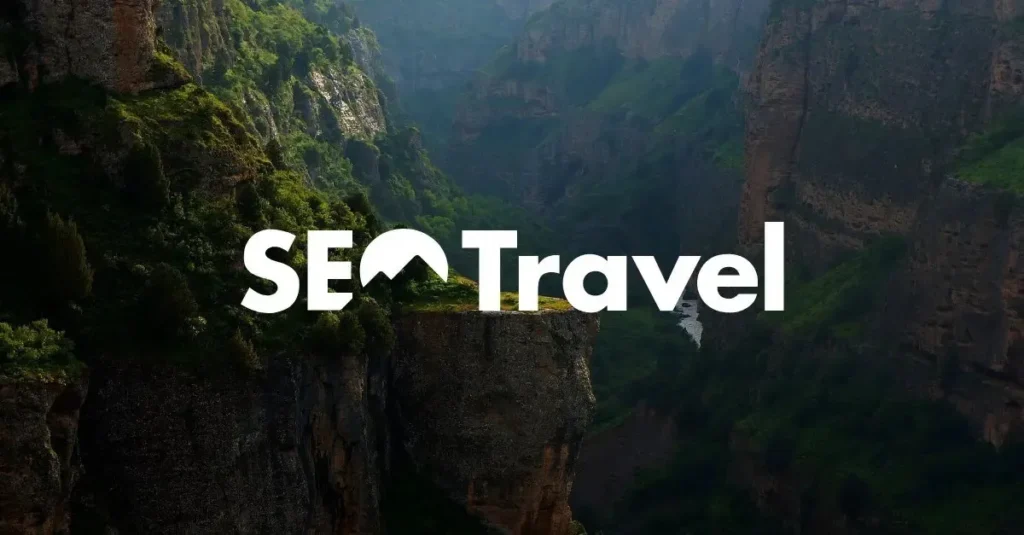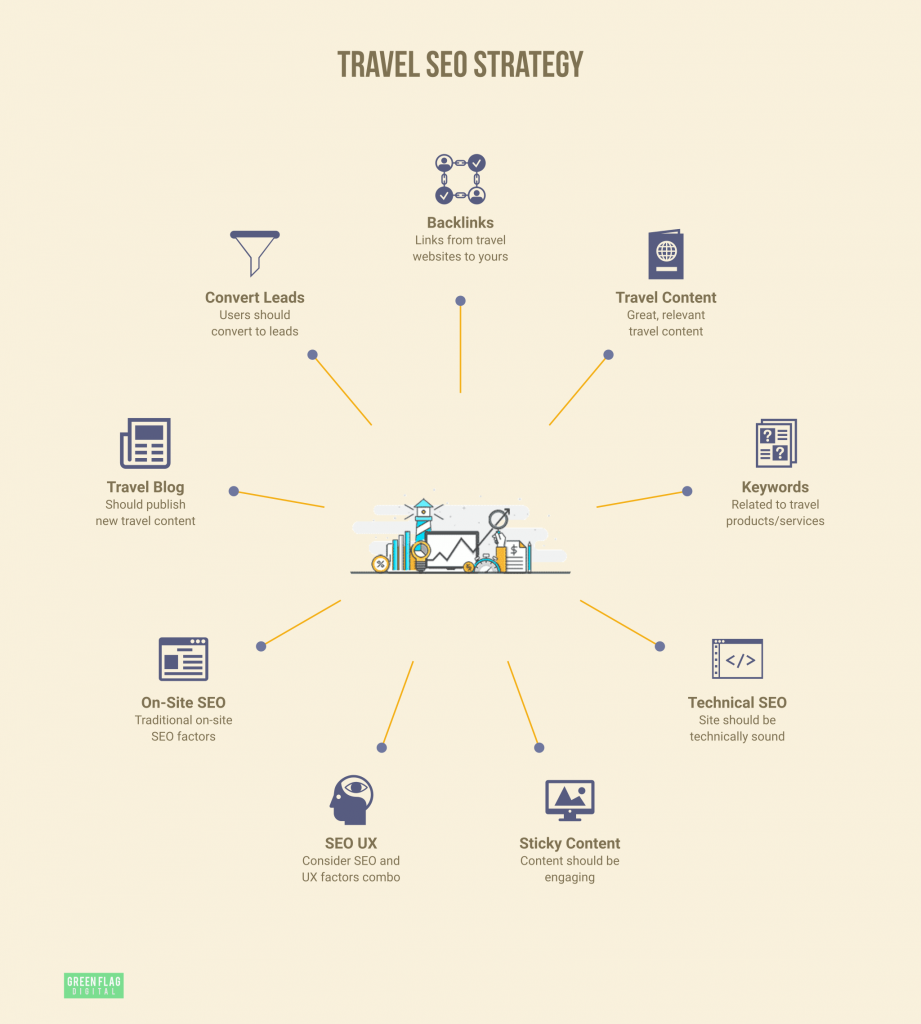
Travel SEO focuses on optimizing travel-related content to rank higher on search engines. It enhances visibility, attracts traffic, and boosts bookings.
For travel businesses, SEO is crucial. It helps in reaching potential customers actively searching for travel services. Optimizing your website with relevant keywords, quality content, and engaging visuals can significantly improve search rankings. Use local SEO to target specific regions and enhance user experience with fast-loading pages and mobile-friendly designs.
Integrate social media to expand reach and build backlinks from reputable sites. Regularly update your content to stay relevant and maintain a competitive edge. Effective Travel SEO not only increases organic traffic but also builds trust and credibility, driving more conversions and ensuring business growth.

Credit: greenflagdigital.com
Introduction To Travel Seo
Travel SEO is crucial for tourism businesses today. It helps travel websites rank higher on search engines. This increases visibility and attracts potential travelers. Understanding Travel SEO can transform your online presence.
Why Seo Matters In Tourism
SEO plays a vital role in the tourism industry. More people search for travel info online. A higher ranking means more traffic to your website.
Consider these benefits of SEO in tourism:
- Increased Visibility: Your website appears on the first page of search results.
- Higher Engagement: More visitors interact with your content.
- Better Conversion Rates: More visitors turn into customers.
Current Trends In Travel Seo
Staying updated with current trends is essential. Here are some important trends to watch:
| Trend | Description |
|---|---|
| Voice Search Optimization | More travelers use voice search. Optimize your content for voice queries. |
| Mobile-First Indexing | Search engines prioritize mobile-friendly websites. Ensure your site is responsive. |
| Local SEO | Local searches are increasing. Optimize for local keywords and listings. |

Credit: www.searchenginejournal.com
Keyword Research
Keyword research is the foundation of effective travel SEO. By finding the right keywords, you can attract visitors to your travel blog or website. This helps increase traffic and boost rankings on search engines.
Finding High-volume Keywords
High-volume keywords are crucial for any travel site. These keywords have a large number of monthly searches. To identify them, use tools like Google Keyword Planner or SEMrush.
- Enter broad travel-related terms like “best travel destinations” or “cheap flights”.
- Look at the monthly search volume and competition level.
- Select keywords with high search volume but moderate competition.
A table can help organize your keyword findings:
| Keyword | Search Volume | Competition |
|---|---|---|
|
best travel destinations |
50,000 | High |
| cheap flights | 30,000 |
Medium |
Long-tail Keywords For Niche Markets
Long-tail keywords are specific and less competitive. They target niche markets and attract highly interested visitors.
- Identify specific travel topics such as “eco-friendly travel tips”.
- Use keyword tools to find related phrases.
- Incorporate these phrases into your content naturally.
Examples of long-tail keywords include:
- “budget-friendly travel destinations in Europe”
- “family-friendly hotels in Orlando”
Using long-tail keywords helps you stand out in niche markets. This attracts a dedicated audience to your travel blog or website.
On-page Seo
On-page SEO is crucial for improving the visibility of your travel website. It focuses on optimizing individual pages to rank higher and earn more relevant traffic. Below, we explore essential aspects of on-page SEO for travel websites.
Optimizing Meta Tags
Meta tags play a vital role in on-page SEO. They provide search engines with information about your page.
- Title Tags: Ensure your title tags are unique and include primary keywords. Keep them under 60 characters.
- Meta Descriptions: Write compelling meta descriptions with secondary keywords. Aim for 150-160 characters.
- Header Tags: Use H1 tags for titles and H2-H6 for subheadings. This helps structure your content better.
Crafting Seo-friendly Content
Creating SEO-friendly content is essential for travel websites. Focus on providing valuable information to your readers.
- Keyword Research: Identify relevant keywords for your niche. Use tools like Google Keyword Planner.
- Content Structure: Break your content into short paragraphs. Use bullet points and numbered lists for better readability.
- Internal Linking: Add internal links to related articles on your site. This helps users navigate and improves SEO.
- Image Optimization: Use high-quality images. Add alt text with keywords to help search engines understand the content.
| Element | Best Practices |
|---|---|
| Title Tags | Include primary keywords, keep under 60 characters |
| Meta Descriptions | Write compelling text with secondary keywords, 150-160 characters |
| Header Tags | Use H1 for titles, H2-H6 for subheadings |
| Keywords | Identify relevant terms, use tools like Google Keyword Planner |
| Internal Linking | Add links to related articles for better navigation |
| Image Optimization | Use high-quality images, add alt text with keywords |
Technical Seo
Technical SEO is crucial for a travel website’s success. It focuses on improving the website’s backend. This ensures better search engine rankings. It also enhances user experience.
Improving Website Speed
Website speed is vital for user satisfaction. A slow site can increase bounce rates. Google prefers faster websites in search results. Use tools like Google PageSpeed Insights to check your site’s speed.
Here are some ways to improve speed:
- Optimize images by compressing them.
- Use browser caching to store files locally.
- Minimize CSS and JavaScript files.
- Implement a Content Delivery Network (CDN).
Mobile-friendly Design
A mobile-friendly design is crucial for travel websites. Many users access sites on their phones. Google uses mobile-first indexing. This means your mobile site affects your rankings.
Ensure your site is responsive. This means it adapts to any screen size. Use flexible images and layouts. Here are some tips for mobile-friendly design:
- Use a responsive theme.
- Test your site on various devices.
- Improve touch elements for easier navigation.
- Ensure fast loading times on mobile.
Here is a quick comparison table:
| Desktop | Mobile |
|---|---|
|
Large images |
Optimized images |
| Complex navigation |
Simple navigation |
|
Full-size videos |
Embedded or smaller videos |
Local Seo Strategies
Boost your travel business using local SEO strategies. They help you reach local tourists and travelers.
Leveraging Google My Business
Google My Business (GMB) is a vital tool. Set up your GMB profile with accurate information.
Include your business name, address, and phone number (NAP). Ensure consistency across all platforms.
Add high-quality photos of your business. They attract more views and engagement.
Encourage customers to leave positive reviews. Respond to them promptly to build trust.
Utilize GMB posts to share updates. These can be special offers or events.
| Action | Benefit |
|---|---|
|
Complete Profile |
Increases visibility |
| Add Photos |
Engages customers |
|
Encourage Reviews |
Builds trust |
| Use GMB Posts |
Shares updates |
Building Local Citations
Local citations are online mentions of your business NAP. They play a crucial role in local SEO.
List your business in local directories. Examples include Yelp and TripAdvisor.
Ensure your NAP details are consistent across all citations. Inconsistent info can harm your SEO.
Use structured and unstructured citations. Structured citations appear in business listings. Unstructured citations appear in blog posts and news articles.
- Structured Citations: Found in directories.
- Unstructured Citations: Found in articles.
Monitor your citations regularly. Update any changes promptly.
Use tools like Moz Local and BrightLocal to manage citations. They help you track and update information efficiently.
Content Marketing
Content marketing is a powerful tool for boosting your travel SEO. It involves creating and sharing valuable content. This helps attract and engage your target audience. Let’s explore how you can leverage content marketing for travel SEO success.
Creating Engaging Travel Guides
Travel guides offer detailed information about destinations. They can attract a lot of traffic. To make them engaging:
- Use high-quality images and videos.
- Include interactive maps.
- Offer insider tips and local secrets.
An engaging travel guide can become a go-to resource. People will share it, boosting your site’s visibility.
Utilizing User-generated Content
User-generated content (UGC) is content created by your audience. It can include reviews, photos, and videos. Encouraging UGC can:
- Increase engagement.
- Build trust.
- Improve SEO.
Here’s how to utilize UGC effectively:
- Create a hashtag for your brand.
- Encourage users to share their experiences.
- Feature the best content on your site.
User-generated content adds authenticity to your travel site. It also provides fresh content for search engines.
Link Building
Link building is crucial for Travel SEO. It helps boost your site’s authority and rankings. By earning backlinks, you can improve your site’s visibility and attract more visitors.
Earning Backlinks From Travel Blogs
Travel blogs are excellent sources for backlinks. They have a dedicated audience interested in travel. Reach out to travel bloggers with unique content. Offer them guest posts or infographics. This can earn you valuable backlinks.
Here are some tips for earning backlinks from travel blogs:
- Identify popular travel blogs in your niche.
- Engage with their content regularly.
- Offer to write guest posts or share useful resources.
- Ensure your content is high-quality and relevant.
Partnering With Influencers
Influencers have a large following and can boost your SEO efforts. Partnering with travel influencers can get your site in front of a new audience. This can lead to more backlinks and traffic.
Here are some ways to partner with influencers:
- Identify influencers who align with your brand.
- Reach out with a personalized message.
- Offer them incentives like free trips or products.
- Collaborate on content like blog posts or social media campaigns.
Using these strategies can enhance your Travel SEO efforts. Earning backlinks from travel blogs and partnering with influencers can significantly improve your site’s authority and traffic.

Credit: seotravel.co.uk
Social Media Integration
Integrating social media into your travel SEO strategy boosts visibility. Social platforms can drive traffic to your travel website. They engage audiences and improve search engine rankings. Here’s how to do it effectively.
Promoting Content On Social Platforms
Use social media to share your travel content. Platforms like Facebook, Instagram, and Twitter are ideal. Share blog posts, travel guides, and stunning photos. Use relevant hashtags to reach a broader audience.
Consider the following tips:
- Post regularly to keep your audience engaged.
- Use eye-catching images and videos.
- Write engaging captions with call-to-action phrases.
Encourage readers to share your posts. This increases your content’s reach and visibility. Use social sharing buttons on your website for easy sharing.
Engaging With Followers
Engage actively with your followers. Respond to comments and messages promptly. Show genuine interest in their travel experiences.
Here are some ways to boost engagement:
- Ask questions in your posts.
- Create polls and surveys.
- Share user-generated content with credit.
Building a community around your travel brand is crucial. It fosters loyalty and encourages repeat visits to your website.
Check this table for quick tips on engagement:
| Action | Benefit |
|---|---|
|
Respond to comments |
Builds relationships |
| Share user content |
Boosts authenticity |
|
Post regularly |
Keeps audience engaged |
Engaging followers on social media strengthens your travel SEO strategy. It drives traffic, builds loyalty, and improves rankings.
Analytics And Tracking
Travel SEO requires a strategic approach. To measure success, use analytics and tracking. This helps you understand your audience and improve your strategy. Key aspects include using Google Analytics and monitoring keyword rankings.
Using Google Analytics
Google Analytics is a powerful tool. It helps you track website performance. You can see how visitors interact with your site.
Important metrics to track include:
- Pageviews: The total number of pages viewed.
- Sessions: The period a user is active on your site.
- Bounce Rate: Percentage of visitors who leave after viewing one page.
- Average Session Duration: The average time users spend on your site.
Use these insights to optimize your content. Improve user experience and increase engagement.
Monitoring Keyword Rankings
Tracking keyword rankings is essential. It shows how well your site ranks for target keywords. Use tools like Google Search Console or third-party SEO tools.
Create a list of your target keywords. Monitor their performance over time.
| Keyword | Current Rank | Previous Rank | Change |
|---|---|---|---|
|
best travel destinations |
5 | 7 | +2 |
| cheap flights | 10 | 12 |
+2 |
By tracking these changes, you can adjust your strategy. Aim to improve your rankings and attract more traffic.
Voice Search Optimization
Voice search is changing how people look for travel information. More travelers now use voice search on smartphones and smart speakers. Optimizing for voice search can help your travel website rank higher. This section covers key strategies for voice search optimization.
Adapting To Voice Search Trends
Voice search is growing fast. People use it for quick and easy answers. Travel websites must adapt to stay competitive. Voice search trends show that people ask full questions, not just keywords.
| Traditional Search | Voice Search |
|---|---|
| “best hotels Paris” | “What are the best hotels in Paris?” |
| “flights to Tokyo” | “Find me flights to Tokyo” |
Adapt your content to match these trends. Use natural language that mimics how people speak. This makes your content more voice search-friendly.
Optimizing For Conversational Queries
Conversational queries are key for voice search. People ask questions in a conversational tone. Your content should provide clear answers to these questions.
- Use FAQs to cover common travel questions.
- Include question phrases like “how,” “what,” “where,” and “why.”
- Answer questions directly in your content.
A well-structured FAQ section can boost your voice search rankings. It offers direct answers that match conversational queries.
Use schema markup to make your answers stand out. This helps search engines understand your content better.
Video Seo
Video SEO is a crucial part of travel content. It helps your travel videos reach a wider audience. Optimizing your travel vlogs can boost your visibility on platforms like YouTube and Google.
Creating Travel Vlogs
Creating travel vlogs can be an exciting way to share your adventures. Begin by choosing engaging destinations. Use high-quality cameras to capture stunning visuals. Include interesting facts about the places you visit. Keep your videos short and engaging. Aim for 5-10 minute videos.
- Choose engaging destinations
- Use high-quality cameras
- Include interesting facts
- Keep videos short and engaging
- Aim for 5-10 minute videos
Engage with your audience by asking questions. Encourage them to leave comments. This boosts engagement and helps your video rank higher.
Optimizing Video Descriptions
Optimizing video descriptions is key for video SEO. Descriptions help search engines understand your content. Use relevant keywords in your descriptions. This increases the chance of your video appearing in search results.
Include a brief summary of your video in the description. Mention the key places you visit. Add timestamps for important sections. This makes it easier for viewers to navigate your video.
| Element | Description |
|---|---|
| Keywords | Include relevant keywords in your description |
| Summary | Provide a brief summary of your video |
| Timestamps | Add timestamps for important sections |
Don’t forget to include a call to action. Encourage viewers to like, share, and subscribe. This helps increase your video’s engagement rate. Use relevant tags to help users find your video. Tags should be related to your video’s content.
- Include a call to action
- Encourage likes, shares, and subscriptions
- Use relevant tags
With these tips, your travel vlogs can reach a larger audience. Optimize your video descriptions to rank higher on search engines. Happy traveling!
Image Optimization
Image optimization is crucial for travel websites. It enhances user experience and boosts SEO ranking. Properly optimized images load faster and rank higher on search engines. Below are essential tips for optimizing images effectively.
Using Alt Text Effectively
Alt text describes an image for search engines and visually impaired users. It plays a critical role in image optimization and SEO. Ensure each image has a unique and descriptive alt text.
- Use relevant keywords naturally in the alt text.
- Keep the description concise but informative.
- Avoid keyword stuffing; it harms SEO.
- Describe the image content accurately.
Compressing Images For Speed
Large images slow down your website, affecting user experience and SEO. Compressing images reduces file size without losing quality. This improves loading speed and ranking.
- Use image compression tools like Tiny PNG or JPEG-Optimizer.
- Save images in web-friendly formats like JPEG and PNG.
- Resize images to the exact dimensions needed.
Below is a table with recommended image dimensions for common travel website elements:
| Element | Recommended Dimensions |
|---|---|
|
Featured Images |
1200 x 800 px |
|
Thumbnails |
150 x 150 px |
| Gallery Images |
800 x 600 px |
Use a Content Delivery Network (CDN) to further speed up image delivery. CDNs distribute your images across multiple servers globally. This ensures faster loading times for your visitors, enhancing their experience and your SEO.
User Experience (UX)
Improving User Experience (UX) is vital for Travel SEO. A seamless UX keeps visitors engaged and reduces bounce rates. This section explores ways to enhance UX for travel websites.
Simplifying Navigation
Clear navigation helps users find information quickly. Use a simple menu structure with clear labels. Organize destinations by regions or themes.
- Use drop-down menus for sub-categories.
- Include a search bar for quick access.
- Add breadcrumbs to guide users back.
Ensure all links are working. Broken links frustrate users and affect SEO.
Enhancing Readability
Readability impacts user experience and engagement. Use short sentences and paragraphs. Break up text with headers and bullet points.
Follow these tips for better readability:
- Use a legible font size and style.
- Opt for high contrast between text and background.
- Include ample white space.
Consider the following table for font and contrast tips:
| Font Size | Contrast Ratio |
|---|---|
|
16px |
7:1 |
| 18px |
4.5:1 |
Images and videos enhance readability. Use alt text for images. It helps with accessibility and SEO.
Schema Markup
Schema Markup helps search engines understand your content better. It uses structured data to provide context. This can improve your website’s visibility and click-through rates. For travel websites, implementing Schema Markup can be very beneficial.
Implementing Schema For Travel
Travel sites can use various Schema types. These include Hotel, Event, and Place. Each type provides specific details to search engines.
For example, a Hotel schema can include:
- Hotel name
- Location
- Star rating
- Price range
Implementing this schema makes it easy for search engines to show relevant information. This helps users find the right hotel quickly.
Here is a simple code snippet for a Hotel schema:
{
"@context": "https://schema.org",
"@type": "Hotel",
"name": "Hotel Sunshine",
"address": {
"@type": "PostalAddress",
"streetAddress": "123 Sunny Road",
"addressLocality": "Beach City",
"postalCode": "12345",
"addressCountry": "US"
},
"starRating": {
"@type": "Rating",
"ratingValue": "4"
},
"priceRange": "$100 - $300"
}
Boosting Rich Snippets
Rich snippets enhance search engine results. They provide more information than regular snippets. For travel websites, rich snippets can display reviews, prices, and availability.
Use the Review schema to showcase customer reviews. This can boost your site’s credibility. A positive review can attract more visitors.
Here is a code snippet for a Review schema:
{
"@context": "https://schema.org",
"@type": "Review",
"itemReviewed": {
"@type": "Hotel",
"name": "Hotel Sunshine"
},
"author": {
"@type": "Person",
"name": "Jane Doe"
},
"reviewRating": {
"@type": "Rating",
"ratingValue": "5"
},
"reviewBody": "Great stay, very clean and friendly staff!"
}
Competitor Analysis
Competitor analysis is crucial for successful Travel SEO. It helps you understand your competitors’ strengths and weaknesses. This knowledge can improve your own strategies.
Identifying Top Competitors
First, identify your top competitors in the travel industry. Use tools like SEMrush or Ahrefs to find competitors. Look for websites that rank high for your target keywords.
Here is a simple table to organize your findings:
| Competitor | Domain Authority | Top Keywords |
|---|---|---|
| TravelSiteA.com | 85 | Travel Tips, Best Destinations |
| TravelGuruB.com | 90 | Luxury Travel, Budget Travel |
Analyzing Competitor Strategies
Once you identify competitors, analyze their strategies. Focus on the following aspects:
- Content Quality: Check the quality and frequency of their content.
- Backlink Profile: Examine the number and quality of backlinks.
- Social Media Presence: Look at their engagement on social platforms.
Here’s a brief outline to guide your analysis:
- Visit competitor websites and note their design and layout.
- Analyze their blog posts for keyword usage and readability.
- Check their backlinks using SEO tools like Moz or Ahrefs.
- Monitor their social media pages for follower count and interaction.
Use this information to improve your own SEO strategies and boost your Travel SEO efforts.
Seasonal SEO Strategies
Seasonal SEO strategies help travel websites stay ahead. These strategies focus on seasonal trends and peak travel times. Adapting your SEO plan can boost visibility and engagement.
Capitalizing On Peak Travel Times
Peak travel times vary by location and season. Identify these periods to tailor your content. Use tools like Google Trends to find popular search terms.
Consider holidays, school vacations, and local festivals. These events can drive more traffic to your site.
| Season | Popular Destinations | Key Search Terms |
|---|---|---|
| Summer | Beaches, National Parks | Summer vacations, beach resorts |
| Winter | Ski Resorts, Warm Destinations | Winter getaways, ski packages |
| Spring | Flower Festivals, City Tours | Spring breaks, city tours |
| Fall | Wine Regions, Scenic Drives | Fall foliage trips, wine tours |
Creating Seasonal Content
Seasonal content attracts visitors planning trips. Create blog posts, guides, and videos for each season.
Update your content with fresh information. Ensure it matches current travel trends.
- Write about seasonal activities and attractions.
- Share travel tips for different weather conditions.
- Create packing lists for each season.
Use keywords related to each season. This will improve your search engine rankings.
Multi-language SEO
In the world of travel, reaching a global audience is essential. Travelers come from diverse backgrounds, speaking different languages. Multi Language SEO Service is crucial for travel websites to cater to an international audience. Let’s explore how optimizing for different languages and using hreflang tags can enhance your travel SEO strategy.
Optimizing For Different Languages
Optimizing your travel website for different languages involves several steps. First, create content in multiple languages. This ensures users can read in their native language. Use professional translators for accuracy. Avoid machine translations as they can be inaccurate.
Next, focus on keyword research for each language. Keywords vary by language and region. Use tools like Google Keyword Planner to find relevant keywords. Make sure the translated keywords fit naturally into the content.
Here are key steps to follow:
- Identify target languages and regions.
- Conduct keyword research for each language.
- Create high-quality translations.
- Optimize meta tags for each language.
- Ensure proper URL structure for multilingual pages.
Using Hreflang Tags
Hreflang tags signal to search engines which language and region a page targets. This improves search visibility for users in different countries. The hreflang tag helps avoid duplicate content issues.
Here is how to implement hreflang tags:
| Language | Hreflang Code |
|---|---|
| English | en |
| Spanish | es |
| French | fr |
Place hreflang tags in the section of your HTML. Use the following syntax:
<!DOCTYPE html>
<html lang="en">
<head>
<meta charset="UTF-8">
<meta name="viewport" content="width=device-width, initial-scale=1.0">
<title>Your Page Title</title>
<link rel="alternate" href="https://example.com/en" hreflang="en">
<link rel="alternate" href="https://example.com/es" hreflang="es">
<link rel="alternate" href="https://example.com/fr" hreflang="fr">
<!-- Add more hreflang tags as needed -->
</head>
<body>
<!-- Page content -->
</body>
</html>Ensure each page has the correct hreflang tags. This helps search engines understand the language and region of the content.
By following these steps, you can effectively target a global audience. Multi-Language SEO is key for the travel industry. Optimize your content and use hreflang tags to reach more travelers.
Conversion Rate Optimization
Conversion Rate Optimization (CRO) is crucial for travel websites. It ensures visitors turn into loyal customers. A high conversion rate means more bookings and increased revenue. Optimizing your travel site’s conversion rate involves several strategies. Let’s dive into the details.
Improving Call-to-actions
Effective Call-to-Actions (CTAs) boost engagement and conversions. A well-placed CTA guides users towards booking. Here are some tips:
- Use action-oriented words like “Book Now” or “Discover More”.
- Ensure CTAs are visible and stand out with contrasting colors.
- Place CTAs strategically, like after a compelling description.
Test different CTA texts and placements. Monitor performance and refine accordingly.
A/b Testing Landing Pages
A/B Testing helps identify the best-performing versions of your landing pages. This process involves creating two versions (A and B) and comparing their performance. Follow these steps:
- Create two variations of your landing page.
- Change one element at a time, like headlines or images.
- Track metrics such as click-through rates and conversion rates.
- Analyze the data to determine the more effective version.
Use tools like Google Optimize or Optimizely for testing. Continuously refine your landing pages for better results.
E-a-t Principles
The E-A-T Principles stand for Expertise, Authoritativeness, and Trustworthiness. They are crucial for SEO success. Search engines value content that reflects these principles. This helps your travel website rank higher and attract more visitors.
Building Trust And Authority
Building trust is essential in travel SEO. Trustworthy websites get better search rankings. To build trust, ensure your website is secure. Use HTTPS instead of HTTP. This shows visitors your site is safe.
Authority comes from high-quality backlinks. These are links from other reputable sites to yours. They tell search engines that your site is credible. You can earn these links by creating valuable content and networking with other travel sites.
| Action | Benefit |
|---|---|
| Use HTTPS | Enhances security and trust |
| Earn High-Quality Backlinks | Increases authority and credibility |
Creating Expert Content
Creating expert content is key to E-A-T. Your content should be informative and accurate. It should provide value to your audience. Expert content answers common travel questions and offers unique insights.
Use bullet points to make content easy to read:
- Include detailed travel guides
- Share personal travel experiences
- Provide up-to-date travel information
Make sure to use credible sources. Cite experts and reliable websites. This boosts your content’s trustworthiness and authority.
Future Of Travel SEO
The travel industry constantly evolves, and so does Travel SEO. Understanding future trends and technologies is crucial. This section explores emerging technologies and predicted trends shaping Travel SEO.
Emerging Technologies
New technologies are transforming the travel industry. Let’s explore some key innovations:
- Artificial Intelligence (AI): AI helps create personalized travel experiences. It can predict traveler preferences and improve search results.
- Voice Search: More travelers use voice assistants to plan trips. Optimizing for voice search is essential for future SEO success.
- Chatbots: Chatbots provide instant customer support. They answer common travel queries and improve user engagement.
Predicted Trends
Several trends will shape the future of Travel SEO. Here are some significant ones:
- Mobile Optimization: More people use mobile devices for travel searches. Websites must be mobile-friendly and load quickly.
- Visual Search: Travelers are using images to search for destinations. Optimizing images for search engines will become crucial.
- Content Quality: High-quality, relevant content will gain more importance. Providing useful information will attract and retain visitors.
- Local SEO: Local search optimization helps attract nearby travelers. It involves using local keywords and optimizing Google My Business listings.
Here is a table summarizing these trends and technologies:
| Technology/Trend | Description |
|---|---|
| Artificial Intelligence | Personalizes travel experiences and improves search results. |
| Voice Search | Optimizes for voice assistants used by travelers. |
| Chatbots | Provides instant customer support and improves engagement. |
| Mobile Optimization | Ensures websites are mobile-friendly and fast. |
| Visual Search | Optimizes images for search engines. |
| Content Quality | Focuses on high-quality, relevant content. |
| Local SEO | Uses local keywords and optimizes Google listings. |
Frequently Asked Questions
What Is Travel SEO?
Travel SEO optimizes travel-related websites to rank higher on search engines. It involves keyword research, quality content, and backlinks.
How Do I Start An SEO Journey?
Start by researching keywords relevant to your niche. Optimize your website content and meta tags. Create high-quality, engaging content. Build backlinks from reputable sites. Monitor your performance with SEO tools.
How Much Does SEO Traffic Cost?
SEO traffic cost varies. It depends on your strategy, goals, and competition. Expect to spend $500 to $5000 monthly.
What Is SEO In Tourism Full Form?
SEO in tourism stands for Search Engine Optimization. It involves strategies to improve a tourism website’s visibility on search engines.
Conclusion
Mastering travel SEO can boost your website’s visibility and attract more visitors. Implement these tips for better rankings and increased traffic. Consistent effort and strategic planning are key. Start optimizing your travel content today to see significant improvements. Happy travels and happy ranking!



Hello! I know this is kinda off topic but I was wondering if you knew where I could get a captcha plugin for my comment
form? I’m using the same blog platform as yours and I’m having difficulty finding one?
Thanks a lot!